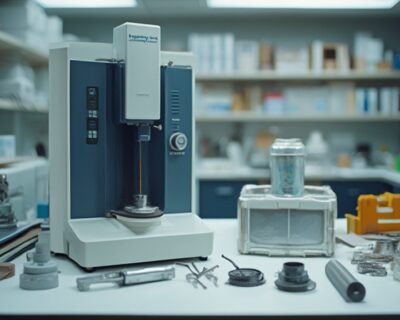Blogs

How to Determine Which Material Has the Highest Hardness: A Step-by-Step Guide
Introduction
In the realm of procurement, the significance of material hardness cannot be overstated. It serves as a cornerstone for evaluating the durability and performance of materials across various applications, directly influencing decision-making processes.
From the Mohs scale’s straightforward scratch resistance ranking to the Rockwell scale’s precise penetration measurements, understanding these methods is essential for procurement managers aiming to select the most suitable materials.
With over 70% of industry professionals identifying hardness testing as critical, the implications of these assessments extend beyond mere numbers; they can lead to substantial improvements in product lifespan and functionality.
This article delves into the intricacies of material hardness, exploring measurement techniques, comparative analyses, and best practices for informed material selection, ultimately equipping procurement professionals with the insights necessary for optimizing their strategies in an ever-evolving market.
Understanding Material Hardness: Key Concepts and Definitions
The rigidity of a substance is characterized by its resistance to deformation, including its capacity to endure permanent alteration, scratching, cutting, or abrasion. This property is essential as it greatly affects the durability and overall performance of substances in different uses. According to expert Slepian, grasping material durability is essential for procurement managers as it directly influences the selection of materials suited for specific applications.
Two widely recognized measurement scales are the Mohs scale and the Rockwell scale:
- The Mohs scale ranks minerals according to their scratch resistance, offering a straightforward approach for comparative assessment.
- In contrast, the Rockwell scale measures the depth of penetration of an indenter under a substantial load, in relation to the penetration made by a preload, offering a quantifiable approach to evaluating material strength.
Recent statistics indicate that over 70% of procurement managers view material testing methods as essential in their decision-making process. Moreover, case studies have indicated that choosing substances with suitable durability can result in a 30% extension of product lifespan in industrial uses. Mastery of these definitions and scales is vital for procurement professionals to accurately assess and select resources that meet the specific performance requirements of their projects.
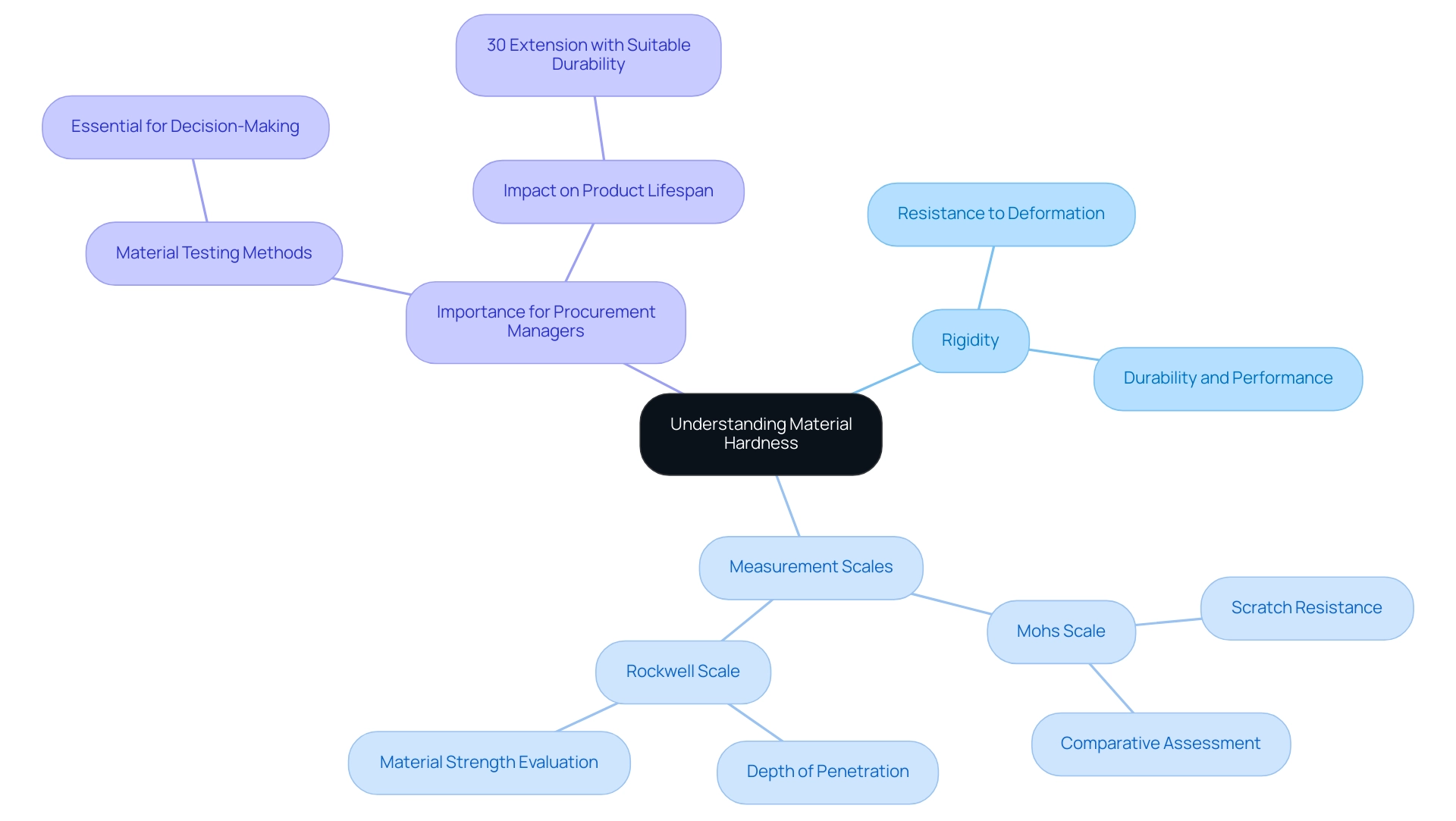
Methods for Measuring Hardness: A Comprehensive Overview
Various techniques are available for assessing substance toughness, each providing distinct benefits suited to particular uses:
Brinell Hardness Test: This method involves pressing a hard steel or carbide ball into the surface of the substance under a specified load. The diameter of the resulting indentation is then measured to compute hardness.
It is particularly effective for materials with coarse or uneven structures, providing valuable insights into material performance.Rockwell Hardness Test: Widely adopted in manufacturing, this method employs a smaller indenter along with a two-step load application—a minor load followed by a major load. Hardness is determined by measuring the depth of penetration, making it a quick and efficient choice that requires minimal sample preparation.
Recent applications illustrate its relevance in quality control processes across various industries. Notably, a constant firmness is reached at loads from 5 N to 100 N, depending on the ceramic being tested, which underscores the importance of load selection in achieving accurate results.Vickers Hardness Test: Utilizing a diamond pyramid indenter, this test applies a load to ascertain the size of the resulting indentation.
Its adaptability enables it to be utilized on all substances, offering a continuous range of firmness values. Notably, this method is beneficial in research settings where precision is paramount. Furthermore, it is essential to consider that the annealing at 455 °C for 570 h has essentially no effects on the thermoelectric properties, metallurgical microstructure, as well as mechanical hardness of the sample, which highlights the stability of certain substances under specific conditions.Mohs Hardness Test: This qualitative evaluation ranks substances by their scratch resistance against one another. While mainly utilized for minerals, it is less precise than other quantitative approaches, making it more suitable for preliminary evaluations rather than detailed assessments.
Knoop Hardness Test: Similar to the Vickers test, this method employs an elongated indenter, which is beneficial for testing brittle substances or thin films.
Its design reduces the chance of harming the sample during testing.
Choosing the suitable measurement technique is essential and should be determined by the substance type, required precision, and specific application requirements. Recent advancements emphasize that optimal outcomes in ceramic firmness testing require indentations greater than the microstructural characteristics of the substance, with several indentations suggested to improve reliability and minimize measurement uncertainty. A case study titled ‘Hardness Testing of Ceramics’ illustrates that the indentation size effect can lead to inaccuracies, with variations in reproducibility reaching as high as 15%.
By comprehending these approaches and their implications, procurement managers can ensure they select the most appropriate testing technique for their resources, thus improving product quality and performance.
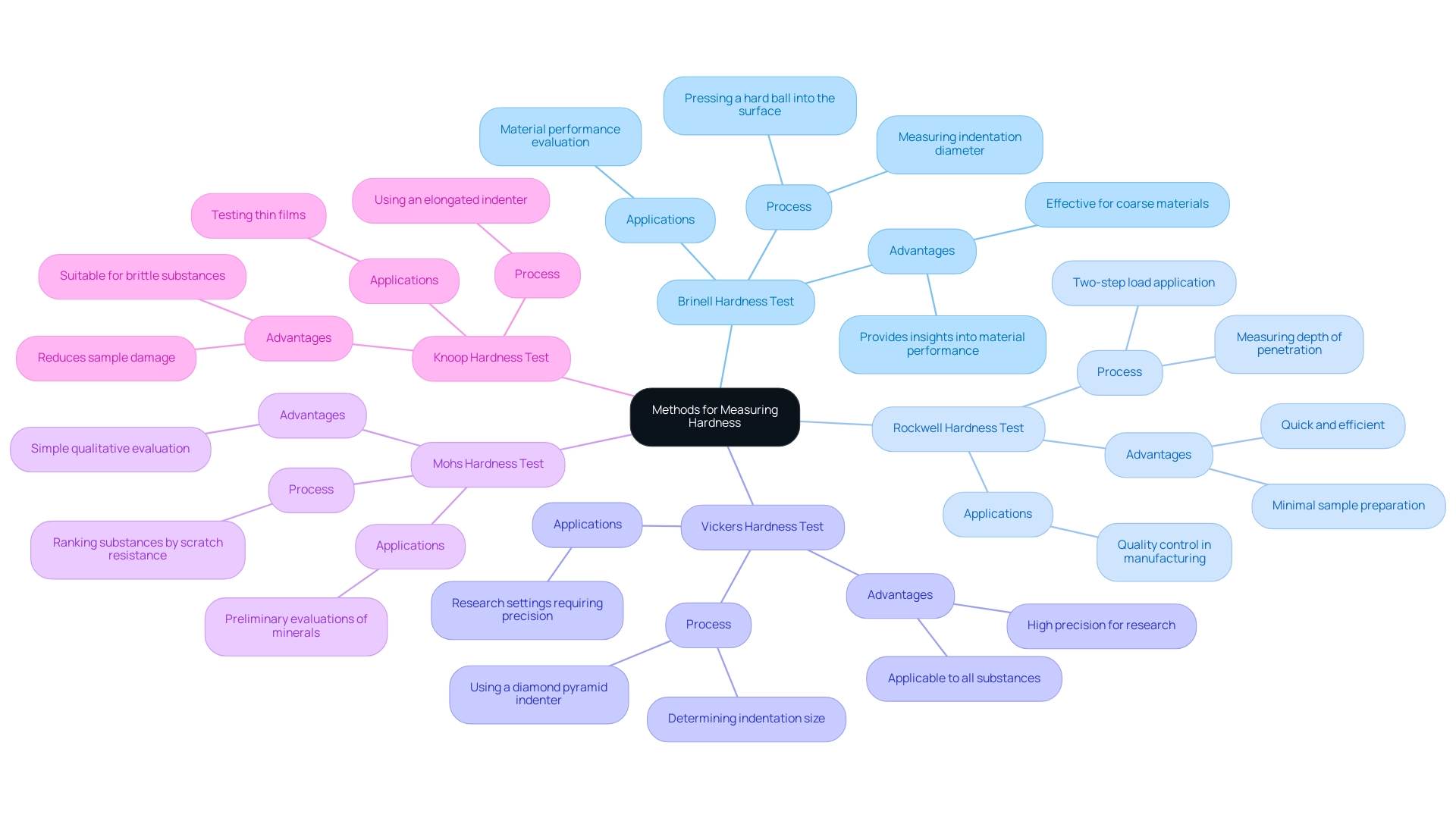
Comparing Hardness Values Across Different Materials
When evaluating durability values across different substances, it is essential to acknowledge the particular testing techniques used, as each technique generates unique scales and values. For example, a substance may achieve a high score on the Rockwell scale, yet this does not guarantee a directly comparable score on the Mohs scale. Therefore, procurement managers should meticulously reference the testing method alongside the durability rating to ensure accurate evaluations.
Furthermore, the selection of substances is heavily influenced by their application: it is important to determine which one of the following materials has the highest hardness, as substances exhibiting higher hardness are often ideal for wear-resistant solutions, whereas softer options may be advantageous in applications requiring greater ductility. In explosive potential environments, Non-Sparking Tools, such as those made from tungsten or cerium, emerge as the best alternative, highlighting the importance of choosing the right substances for safety and efficacy. Providers and producers of electrical insulation and high-temperature substances, including electrical insulation paper, PTFE coated yarn, and high-temperature fabrics, play a pivotal role in supplying these essential resources.
For example, Kawara et al. performed scratch evaluations of thermoplastic denture base resins, emphasizing the practical implications of strength testing methods in real-world applications. Furthermore, recent research has indicated that Candida biofilms exhibited considerably greater growth on polyamide in comparison to PMMA, highlighting the significance of selection based on durability characteristics.
By cross-referencing material values with specific performance requirements, procurement professionals can make optimal selections that align with both functional and durability needs. According to Uzun et al., all substances had a similar toxic effect in the short term and reached the highest levels of toxicity after 8 weeks of aging, further illustrating the importance of strength testing and selection in ensuring safety and effectiveness.
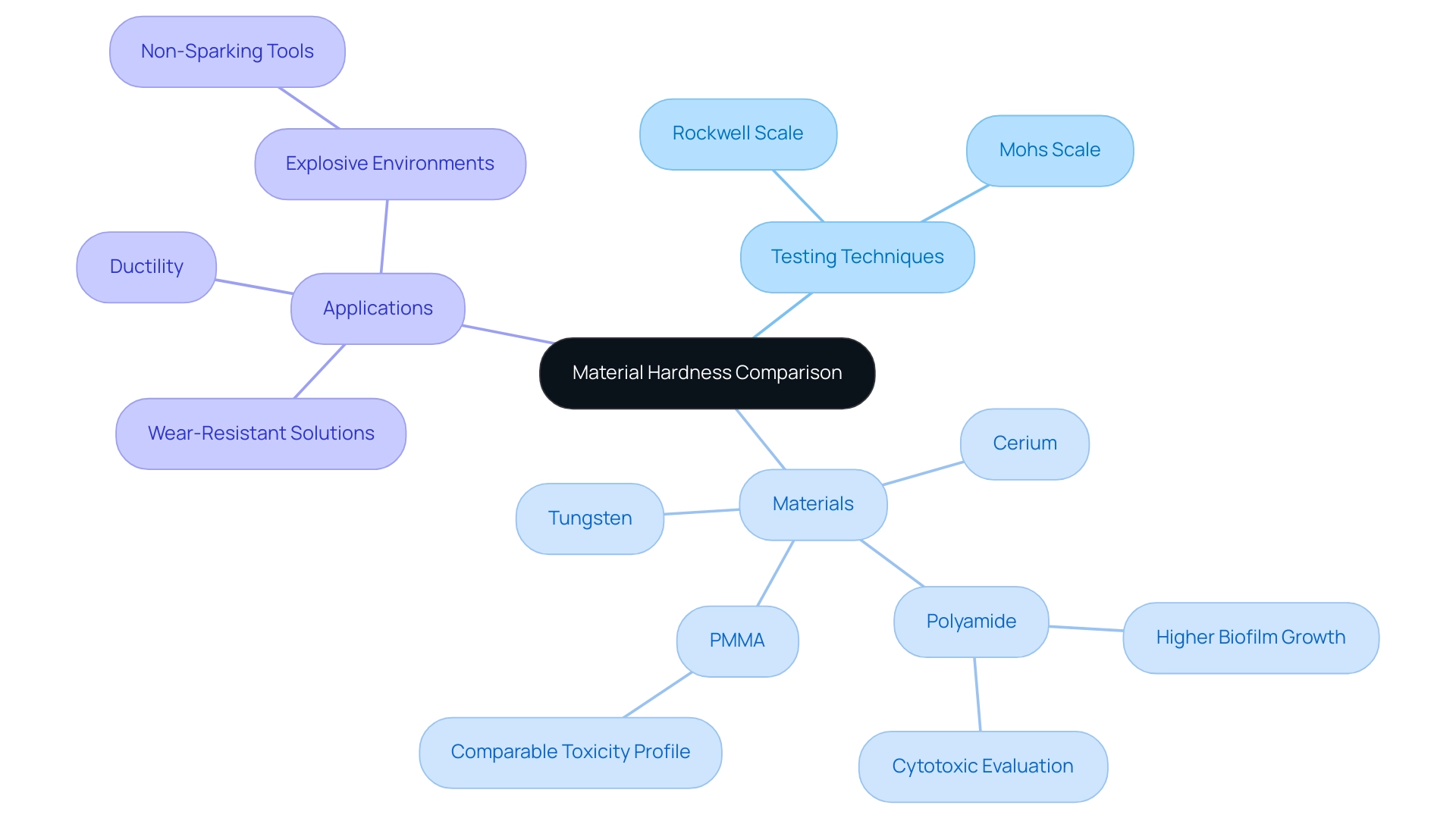
Interpreting Material Hardness in Application Contexts
In assessing the performance and appropriateness of resources across diverse uses, particularly in industries reliant on high-quality electrical insulation solutions, it is important to determine which one of the following materials has the highest hardness. For instance, Mica Tapes, produced under strict quality control to meet international standards, consist of mica paper bonded to flexible substances, making them essential in electric motors, generators, and transformers. These tapes ensure durability in high-voltage environments, contributing significantly to the overall functionality of electrical systems.
Similarly, electrical wire insulation sleeves provide crucial protection against physical damage and electrical interference thanks to their high dielectric strength, flame retardance, flexibility, and abrasion resistance. These specifications are vital for maintaining the integrity of cables in demanding applications. Procurement managers should also consider Non-Sparking Tools in explosive environments, where avoiding sparks is critical for safety.
Furthermore, the use of DOMADIA Oxygen Free Copper, recognized for its high conductivity and purity, in essential medical components emphasizes the significance of selection. Recent advancements highlight that while high stiffness often indicates durability, it is essential to determine which one of the following materials has the highest hardness to achieve a balance with ductility and prevent brittleness. This dual consideration is vital for procurement managers when selecting substances that meet performance criteria across automotive and electronic uses, ensuring that the chosen substances not only enhance functionality but also guarantee reliability in their uses.
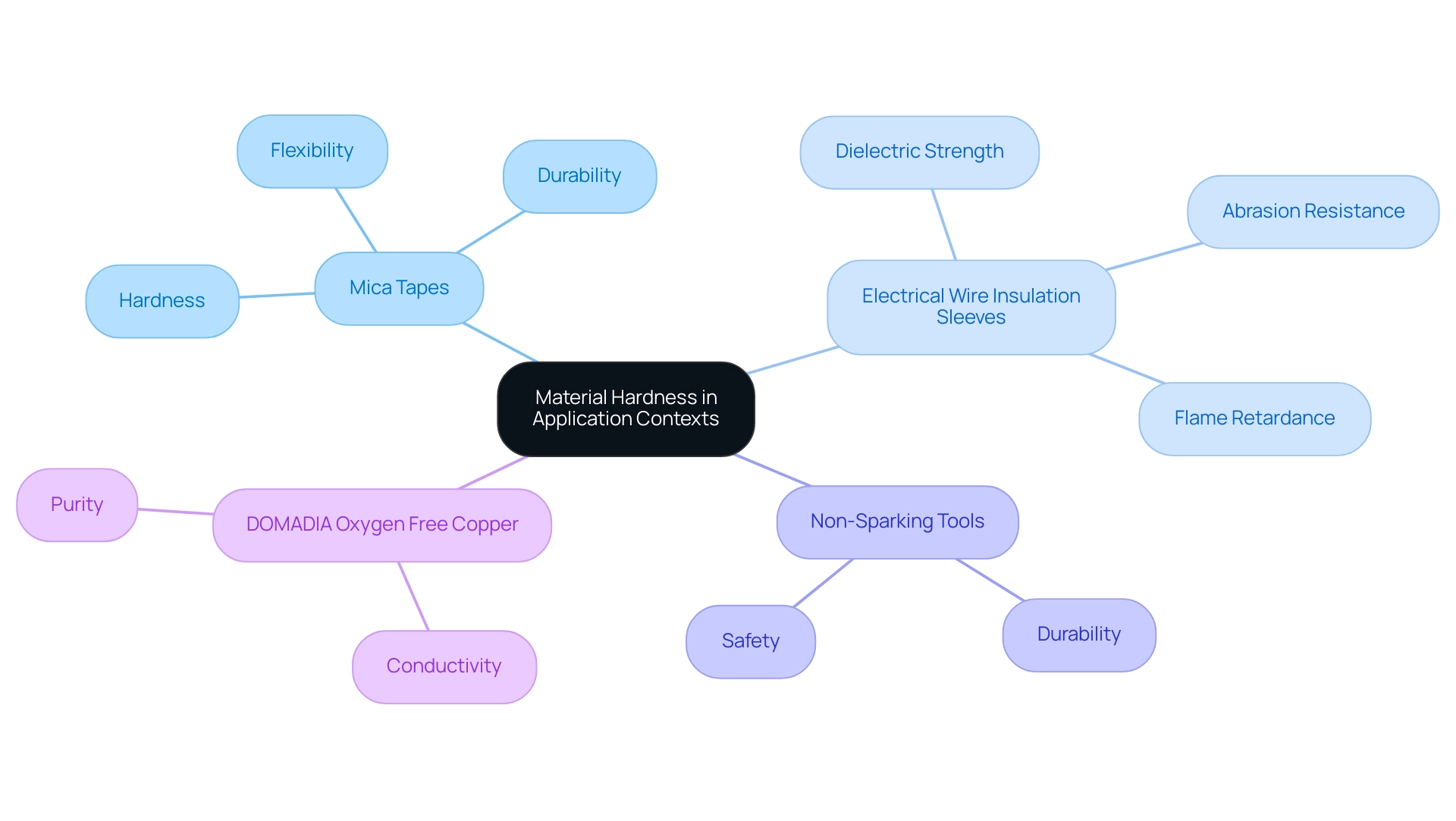
Best Practices for Material Selection Based on Hardness
To effectively choose resources based on durability, procurement managers should follow these best practices:
Define Application Requirements: Establishing clear performance criteria is essential. This involves defining the required toughness, ductility, and other mechanical characteristics that the substance must have for its intended use. As Canfield (2005) emphasizes, successful individuals ‘take the time to understand what they’re here to do—and then they pursue that with passion and enthusiasm.’ This mindset is crucial in resource selection, as comprehending usage requirements directly affects the quality of the procurement process.
Select Suitable Testing Techniques: It is essential to pick the testing methods that correspond with the kind of substance and its application context. Utilizing the right testing protocols guarantees reliable and relevant results, thereby supporting informed decision-making.
Consult Standards and Compliance Guidelines: Reference international standards and compliance guidelines to ensure that chosen substances fulfill industry requirements and specifications. This practice not only aids in quality assurance but also mitigates risks associated with non-compliance.
Build Relationships with Suppliers: Cultivating long-term connections with suppliers who are well-versed in your hardness requirements can significantly enhance quality. Significantly, providers of Non-Sparking Tools and high-temperature electrical insulation resources, such as electrical insulation papers and high-temperature fabrics offered by Domadia, can deliver insights and products customized to fulfill your requirements. A trusted supplier can consistently provide resources that meet your specifications, ensuring reliability in your procurement processes.
Continuously Review and Update Selection Choices: Regularly assess the performance of chosen resources in their applications. Stay informed about advancements in material science, particularly focusing on which one of the following materials has the highest hardness, as this could present superior alternatives, thereby keeping your procurement strategies agile and competitive.
By implementing these best practices, procurement managers can optimize their material selection processes, ensuring that they choose materials that fulfill the necessary hardness requirements while aligning with the evolving landscape of material science. Additionally, it is important to properly cite sources when using direct quotes to enhance the credibility of the information presented. For more information on our range of products, including Mica Tapes and other high-temperature electrical insulation solutions, visit our website or contact our expert team at Domadia today.
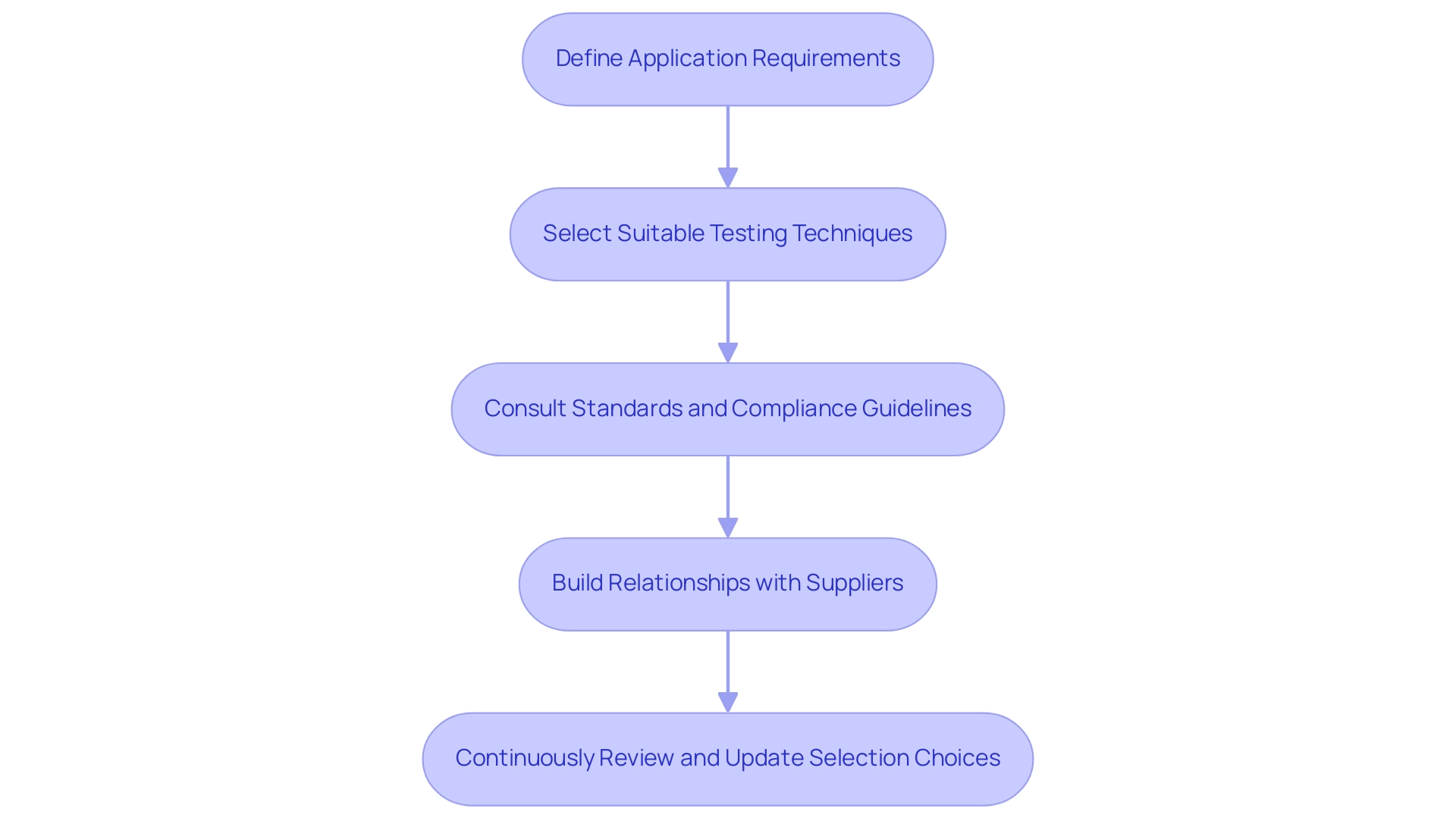
Conclusion
Understanding material hardness is fundamental for procurement managers striving to make informed material selections that enhance product durability and performance. Throughout this article, key measurement techniques, including the Brinell, Rockwell, Vickers, Mohs, and Knoop hardness tests, have been explored, highlighting their unique advantages and applications. Each method plays a crucial role in assessing the suitability of materials across various sectors, ensuring that procurement decisions align with specific performance requirements.
The comparison of hardness values across different materials underscores the importance of referencing the applicable testing methods, as discrepancies may arise between scales. This knowledge enables procurement professionals to choose materials that not only meet functional criteria but also align with safety and efficacy standards, particularly in high-stakes environments like electrical insulation and explosive settings.
Incorporating best practices into the material selection process—such as:
- Defining application requirements
- Selecting appropriate testing methods
- Consulting standards
- Building supplier relationships
- Continuously reviewing material choices
empowers procurement managers to navigate the complexities of material hardness effectively. By adhering to these practices, organizations can enhance their procurement strategies, ultimately driving improvements in product quality and longevity in an ever-evolving market.


